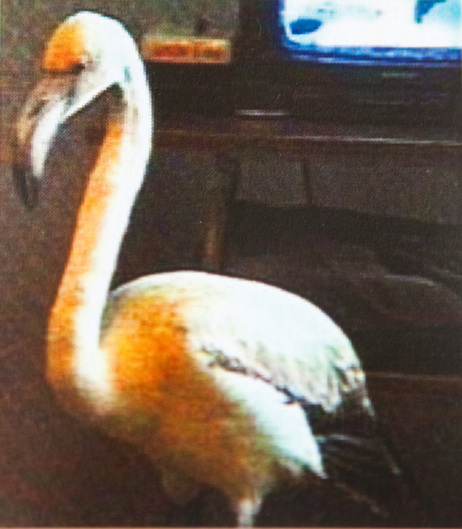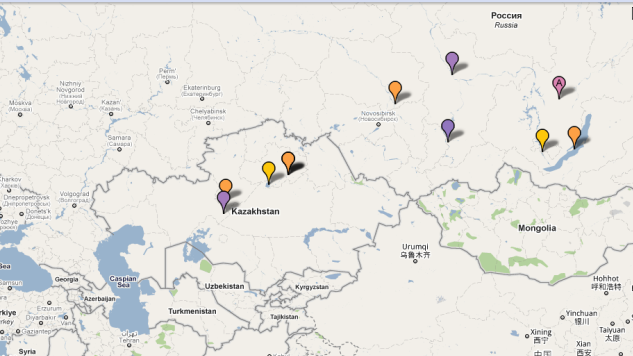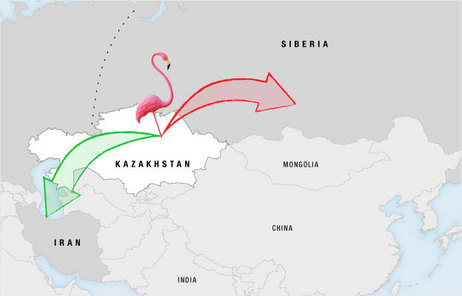Flamingos Fall From Skies
Posted by: Loren Coleman on March 7th, 2011


The flamingo in the Muravyev’s apartment. Credit: spb.kp.ru
Flamingos have fallen from the sky in Siberia. It was discussed on NPR’s Morning Edition today. Push the “listen” button on this page to hear the story, but below is part of the transcript of this news.
We’re in Siberia, shivering. It’s November, November 11, 2003, and two boys, Kolya and Maksim Muravyev, are ice fishing along the Lena River, where it’s 13 below zero. All of a sudden, up in the sky, they see what looks like a flamingo. “We thought it was a swan or a stork,” Kolya says, a flamingo being so preposterously improbable.
It was large, and made ever lower circles in the sky. It seemed to be losing energy until finally it fell and lay quietly on the snow. The two boys ran over, called their father, Vasily, who picked up the bird and took it home. It was still alive. “[This is the ] first time I see a bird like this,” he told a TV reporter.
They fed the flamingo fish and buckwheat saturated in water (not normally flamingo food) and pretty soon it was up, active and knocking around the Muravyev’s apartment. Here it is, head in a feeding bucket.
The Muravyevs have a dog. Dogs and flamingos don’t cohabit easily in living rooms, so the flamingo was eventually moved to a local greenhouse and then to the zoo in nearby Krasnoyarsk.
That should be the end of the story. Except that one year later, also in November and also in Siberia, it happened again. Another flamingo flew out of the sky, landed by another Siberian river, was also brought to the greenhouse, then sent to the zoo and the locals began to wonder, “Where are these birds coming from? What are they doing here?”
This tale appears in Ian Frazier’s new and wonderful travelogue, Travels in Siberia and when I read it, I called up my buddy (and sleuth-on-tap) Ezra Block and said, “Let’s see if we can solve this puzzle.”
Flamingos Aren’t Always Warm
Ezra checked and discovered that while we normally associate flamingos with tropical lagoons, they are not always warm weather birds. Marita Davison, who studies flamingos at Cornell University, says she regularly sees Bolivian flamingos up in the Andes Mountains. And at that high up — 16,000 feet — the lakes freeze around their feet. She sent us this video of flamingos stuck in ice. There are two on the right trying to get free.
“It’s really an amazing sight to see,” she told us. “They’ll just wait for it to thaw and then go on [with] their business.” So, we asked her, were you surprised to hear about flamingos in Siberia?
She was. First of all, Siberia in November is much colder than Bolivia. Then she pointed out, flamingos are social animals. They always travel in flocks. To have two single flamingos drop from the sky suggests that there were more flamingos up there, that the two who fell were part of larger groups. (Meaning, there could be flocks of Siberian flamingos flying over Siberia! )
Where did they come from? There are Asian flamingos. The nearest live and nest in Kazakhstan, so perhaps those birds came from there. It’s a long way, as you see here:

Google Maps
A map of flamingo sightings in Kazakhstan and Siberia.
So what brought them so far north and east? Davison isn’t sure, but she has a notion. We were checking the library, she discovered that 100 years ago scientists also reported multiple sightings of flamingos, again deep in Siberia, and again it was November.
November is the month when flamingos normally fly south from their nests in Kazakhstan to Iran. So, she thought, maybe this is an example of “reverse migration,” a behavior known in migrating birds but not – thus far — in flamingos.
Here’s the idea. Suppose a bird is wired to fly one direction every fall and for some reason the wiring screws up so the animal goes 180 degrees the wrong way, exactly the opposite direction. This happens to a few birds in migrant populations every year. When she looked on a map, she noticed that the village of Vernemarkovo in Siberia, where the first bird landed, was roughly the opposite distance and the opposite direction from the flamingo’s normal winter quarters in Iran.

Stephanie d’Otreppe/NPR
So maybe what happened is a bunch of birds in 2003 and 2004 got turned around on their way to Iran, and flew exactly where they didn’t want to go. By this logic, they weren’t the first flamingos in Siberia and they won’t be the last.So this may not be a global warming story or a one-in-a-billion story or a winter miracle. It may be just a statistically predictable case of faulty wiring that brightened up the winter for two sets of boys in Siberia.
As for the birds, they got names: Phila and Phima, and a warm place to live at the Krasnayarsk Zoo, which they shared with a bunch of (imported) zoo flamingos. Until one of them got sick. We called the zoo and a spokesman told us that one of the birds died “after a long illness”. One imagines the surviving flamingo quietly dreaming of warm nights in Persia, sipping pond-scum, their favorite food. The flamingos we know don’t care much for borscht. Source.
Ian Frasier, while researching his “Travels in Siberia” (2010, Farrar, Strauss and Giroux) recorded an interview with Marina Tabakova, who took care of both flamingos at the Winter Garden in Severobaikalsk in Siberia. He generously allowed NPR to use his recordings.
About Loren Coleman
Loren Coleman is one of the world’s leading cryptozoologists, some say “the” leading living cryptozoologist. Certainly, he is acknowledged as the current living American researcher and writer who has most popularized cryptozoology in the late 20th and early 21st centuries.
Starting his fieldwork and investigations in 1960, after traveling and trekking extensively in pursuit of cryptozoological mysteries, Coleman began writing to share his experiences in 1969. An honorary member of Ivan T. Sanderson’s Society for the Investigation of the Unexplained in the 1970s, Coleman has been bestowed with similar honorary memberships of the North Idaho College Cryptozoology Club in 1983, and in subsequent years, that of the British Columbia Scientific Cryptozoology Club, CryptoSafari International, and other international organizations. He was also a Life Member and Benefactor of the International Society of Cryptozoology (now-defunct).
Loren Coleman’s daily blog, as a member of the Cryptomundo Team, served as an ongoing avenue of communication for the ever-growing body of cryptozoo news from 2005 through 2013. He returned as an infrequent contributor beginning Halloween week of 2015.
Coleman is the founder in 2003, and current director of the International Cryptozoology Museum in Portland, Maine.









